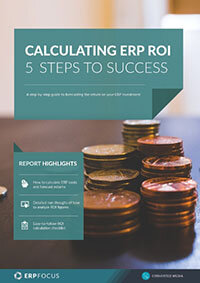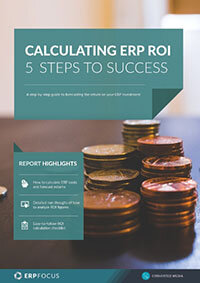ERP ROI: Analyzing the Final Figures
By now you have completed most of the hard work involved in calculating ERP ROI. You have a good estimate of your costs and returns for the ERP system. You and your team have examined the factors and agree that the numbers are as accurate as you can get them. You have shared those numbers with people throughout your enterprise as communication is a crucial part of ERP projects.
All you have to do now is plug the numbers into the simple ROI formula and see if the answer is positive. ROI = (returns minus costs) divided by costs. Show the quotient as a percentage. If it is positive, you have an expected gain and if it is negative, an expected loss.
If you think the job of analyzing ERP ROI is complete, take a look. There are still a few column inches left below.
It’s Just Not That Simple
Is this proposed ERP system the only possible opportunity to invest the company’s money? Probably not. Production staff are looking at a new automated assembly line. The marketing department are looking for product innovations in the next major release. The folks in the supply chain group want some new software of their own. Meanwhile, the finance department warn all that the money pit is not bottomless.
Recommended Reading: ERP Selection Survival Guide - the 10 proven steps you should know about ERP selection
Here is where some of the power of analyzing ERP ROI comes into play. Perform the same analysis on returns and costs for other potential investments. Wherever possible, use the same practices to ensure the calculations are consistent. Now take a look. If ERP shows 28% and the factory automation system yields 32% and there is only money for one or the other then it looks like the choice is made.
Qualitative Factors
Don’t stop there though; ERP ROI is really a simple metric and has most value as a first-pass analytic. If the ROI for your ERP system was negative, your consideration would probably be over. But there could be some qualitative factors to consider as well and these often cannot be measured in the same money-based metrics.
Now is probably the time to bring risk factors and timing of the costs and returns into play.
Size of the required investment comes into play as well. If you only have $500K, any potential investment above that amount might be removed from consideration regardless of the ERP ROI.
Now is probably the time to bring risk factors and timing of the costs and returns into play. These analyses are more complex than ROI but you have reduced the list of potential investments competing with ERP to only a few, so the workload should also be reduced. Take the time to analyze ERP ROI in the context of return schedules and cost risks. If that ERP system is still the best choice after these analyses, it is time to start your ERP selection search.
Free white paper

Calculating ERP ROI: 5 steps to success
Calculate your new ERP's financial benefits with this comprehensive guide

Featured white papers
Related articles
-
![Three direct links between ERP and manufacturing revenue [image by Snowing on Freepik] Three direct links between ERP and manufacturing revenue [image by Snowing on Freepik]](/pictures/W1siZiIsIjIwMjUvMDEvMjAva2ZwYjAzb3gzX1RocmVlX2RpcmVjdF9saW5rc19iZXR3ZWVuX0VSUF9hbmRfbWFudWZhY3R1cmluZ19yZXZlbnVlX2ltYWdlX2J5X1Nub3dpbmdfb25fRnJlZXBpa18uanBnIl0sWyJwIiwidGh1bWIiLCI0MDB4MjY2IyJdLFsicCIsImVuY29kZSIsImpwZyIsIi1xdWFsaXR5IDg1Il1d/Three%20direct%20links%20between%20ERP%20and%20manufacturing%20revenue%20%5Bimage%20by%20Snowing%20on%20Freepik%5D.jpg?sha=b45b02a140cc8680)
Three direct links between ERP and manufacturing revenue
What you need to know to help you achieve a return on your manufacturing ERP investment
-

CMMC Compliance: What Aerospace and Defense Manufacturers Need to Know
Key insights on CMMC compliance, deadlines, and securing DoD contracts with CMMC 2.0 certificatio...
-
![3 Tips for Achieving Buy-In for Your ERP Integration [by pressfoto on Freepik] 3 Tips for Achieving Buy-In for Your ERP Integration [by pressfoto on Freepik]](/pictures/W1siZiIsIjIwMjQvMTAvMjkvNnQyNmRwdzdwYl8zX1RpcHNfZm9yX0FjaGlldmluZ19CdXlfSW5fZm9yX1lvdXJfRVJQX0ludGVncmF0aW9uX2J5X3ByZXNzZm90b19vbl9GcmVlcGlrXy5qcGciXSxbInAiLCJ0aHVtYiIsIjQwMHgyNjYjIl0sWyJwIiwiZW5jb2RlIiwianBnIiwiLXF1YWxpdHkgODUiXV0/3%20Tips%20for%20Achieving%20Buy-In%20for%20Your%20ERP%20Integration%20%5Bby%20pressfoto%20on%20Freepik%5D.jpg?sha=0e1a55a6cfcac344)
3 tips for achieving buy-in for your ERP integration
Read our expert’s tips on getting your ERP integration project off the ground by achieving busine...


